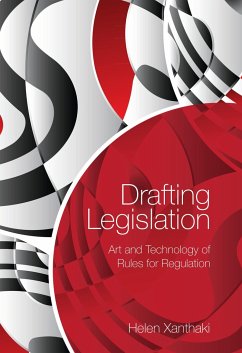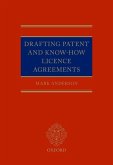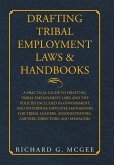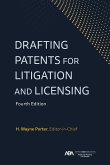- Gebundenes Buch
- Merkliste
- Auf die Merkliste
- Bewerten Bewerten
- Teilen
- Produkt teilen
- Produkterinnerung
- Produkterinnerung
This book constitutes the first thorough academic analysis of legislative drafting. By placing the study of legislation and its principles within the paradigm of Flyvberg's phronetic social sciences, it offers a novel approach which breaks the tradition of unimaginative past descriptive reiterations of drafting conventions. Instead of prescribing rules for legislation, it sets out to identify efficacy as the main aim of the actors in the policy, legislative and drafting processes, and effectiveness as the main goal in the drafting of legislation. Through the prism of effectiveness as…mehr
Andere Kunden interessierten sich auch für
![Legislative Drafting Legislative Drafting]() Legislative Drafting168,99 €
Legislative Drafting168,99 €![Drafting Agreements for the Digital Media Industry Drafting Agreements for the Digital Media Industry]() Alan WilliamsDrafting Agreements for the Digital Media Industry177,99 €
Alan WilliamsDrafting Agreements for the Digital Media Industry177,99 €![Development and drafting of the Pan-African Investment Code Development and drafting of the Pan-African Investment Code]() Ihab ALI GADDAYEDevelopment and drafting of the Pan-African Investment Code41,99 €
Ihab ALI GADDAYEDevelopment and drafting of the Pan-African Investment Code41,99 €![Drafting Patent and Know-How Licencing Agreements Drafting Patent and Know-How Licencing Agreements]() Mark AndersonDrafting Patent and Know-How Licencing Agreements254,99 €
Mark AndersonDrafting Patent and Know-How Licencing Agreements254,99 €![Drafting Tribal Employment Laws & Handbooks Drafting Tribal Employment Laws & Handbooks]() Richard G McGeeDrafting Tribal Employment Laws & Handbooks28,99 €
Richard G McGeeDrafting Tribal Employment Laws & Handbooks28,99 €![Legal Constraints on EU Member States in Drafting Accession Agreements Legal Constraints on EU Member States in Drafting Accession Agreements]() Narin IdrizLegal Constraints on EU Member States in Drafting Accession Agreements98,99 €
Narin IdrizLegal Constraints on EU Member States in Drafting Accession Agreements98,99 €![Drafting Patents for Litigation and Licensing, Fourth Edition Drafting Patents for Litigation and Licensing, Fourth Edition]() Drafting Patents for Litigation and Licensing, Fourth Edition483,99 €
Drafting Patents for Litigation and Licensing, Fourth Edition483,99 €-
-
-
This book constitutes the first thorough academic analysis of legislative drafting. By placing the study of legislation and its principles within the paradigm of Flyvberg's phronetic social sciences, it offers a novel approach which breaks the tradition of unimaginative past descriptive reiterations of drafting conventions. Instead of prescribing rules for legislation, it sets out to identify efficacy as the main aim of the actors in the policy, legislative and drafting processes, and effectiveness as the main goal in the drafting of legislation. Through the prism of effectiveness as synonymous with legislative quality, the book explores the stages of the drafting process; guides the reader through structure and sections in their logical sequence, and introduces rules for drafting preliminary, substantive and final provisions. Special provisions, comparative legislative drafting and training for drafters complete this thorough analysis of the drafting of legislation as a tool for regulation. Instead of teaching the reader which drafting rules prevail, the book explores the reasons why drafting rules have come about, thus encouraging readers to understand what goal is served by each rule and how each rule applies. The book is aimed at academics and practitioners who draft or use statutory law in the common or civil law traditions.
Produktdetails
- Produktdetails
- Verlag: Bloomsbury 3PL
- Seitenzahl: 402
- Erscheinungstermin: 16. Oktober 2014
- Englisch
- Abmessung: 240mm x 161mm x 26mm
- Gewicht: 766g
- ISBN-13: 9781849464284
- ISBN-10: 1849464286
- Artikelnr.: 41099397
- Herstellerkennzeichnung
- Libri GmbH
- Europaallee 1
- 36244 Bad Hersfeld
- gpsr@libri.de
- Verlag: Bloomsbury 3PL
- Seitenzahl: 402
- Erscheinungstermin: 16. Oktober 2014
- Englisch
- Abmessung: 240mm x 161mm x 26mm
- Gewicht: 766g
- ISBN-13: 9781849464284
- ISBN-10: 1849464286
- Artikelnr.: 41099397
- Herstellerkennzeichnung
- Libri GmbH
- Europaallee 1
- 36244 Bad Hersfeld
- gpsr@libri.de
Professor Helen Xanthaki is Professor of Law at UCL; Director of the International Postgraduate Laws Programme of the University of London; and Senior Research Fellow at the IALS, University of London. She is a leading expert in legislation, law-making and legislative quality. She was the first and only Professor of Legislative Drafting in the UK, and served for 18 years at the Sir William Dale Centre for Legislative Studies (most of them as the Director). She have published extensively in the field of legislation and legislative drafting, most recently as the author of two books in the field: Helen Xanthaki, Drafting Legislation: Art and Technology of Rules for Regulation (2014, Hart Publishers, Oxford)[1]; and Helen Xanthaki, Thornton's Legislative Drafting 5th Edition, (2013, Bloomsbury, London). She has edited two collections: Helen Xanthaki, (ed) Enhancing Legislative Drafting in the Commonwealth: A Wealth of Innovation (2014, Routledge, London); and the forthcoming Ulrich Karpen and Helen Xanthaki (eds), Legislation in Europe: A Handbook for Scholars and Practitioners, forthcoming Hart Publishers, Oxford). She has contributed to most journals in the field, including the Theory and Practice of Legislation, Statute Law Review, Hukim Journal on Legislation, European Journal of Law Reform, The Korean Legal Research Institute Journal of Legislation and Evaluation, Studi parlamentari e di politica costituzionale. She has offered evidence to the House of Lords, the House of Commons, the European Commission, the European Parliament (Legal Affiars Committee). She has served as a consultant to the European Commission, the European Parliament, governments, the World Bank and many other national, regional, and international fora. [1] Reviewed in Public Law, Legal Studies, The Loophole, the Statute Law Review, Theory and Practice of Legislation, European Journal of Law Reform, Rassegna Parlamentare, Zeitschift fur Gesetzgeburg.
1. Legislation as a Means of Regulation: Effectiveness
in Legislative Drafting
Introduction
The Nature of Rules for Regulation: Art or Technology?
The Universality of Rules for Regulation
Compilations of Rules for Regulation: Homogeneity versus Rigidity?
Conclusions
2. Drafting Instructions
What are Drafting Instructions?
Purposes of Drafting Instructions .
The Four Principles of Drafting Instructions
What is the Content of Drafting Instructions?
Quality of Legislative Instructions
Style of Drafting Instructions
Conclusions: a Checklist for Quality Drafting Instructions
To Sum Up: Checklist for Legislative Instructions
3. The Legislative Plan: Designing a Legislative Solution
Designing a Legislative Solution: What is it?
The Advantages of Compiling a Legislative Plan
The Elements of Analysis in the Legislative Plan
Analysis of the Existing Law
Analysis of the Necessity of Legislation as a Solution
to the Identified Social Need
Analysis of Potential Danger Areas
Analysis of the Policy Options and the Preferred Legislative Solution
Analysis of the Projected Interpretation of the Legislation
Initial Considerations of Structure: Thring's Five 'Golden Rules'
Conclusions
4. Structure of a Bill
The Theory: Lord Thring's Five Rules of Drafting Revisited
More Doctrine: Bergeron's Rules
The Practice: Thornton's Approach
Structure in Brief: the Traditional Style
Structure in Brief: Innovation
Arrangements in Parts
Headings
Sections
Marginal Notes
Marginal References
Table of Arrangements or Arrangement of Sections
Real Innovation: the Layered Approach
An Example of the Layered Approach in Action:
The Succession to Crown Act 2013 (UK)
5. Clarity, Precision, Unambiguity and the Legislative Sentence
The Basics
Ambiguity and Vagueness
Semantic Ambiguity
Common Problems with Small Words: May, Shall, And/Or
Unless-Except
Scale Indicators
Terms Conveying Ranges of Numbers, Days, Dates and Ages
That and Which
Serial Commas and Ambiguity
Syntactic Ambiguity or Ambiguity at the Sentence Level
The Placement Problem
Modifiers of Nouns
Punctuation: Thornton's Four Rules of Punctuation
Gender-Neutral Drafting (gnd)
6. Plain Language
What is Plain Language?
Plain Language Aspect 1: Knowing your Audience
Plain Language Aspect 2: Easy Communication
Common Problems of Legislative Texts
Best Practices for an Easy Communication: Plain Language Innovations
The Debate: Concerns with Plain Language
Concern 1: Plain Language Lowers the Standards
of Good Writing
Concern 2: Intelligibility
Concern 3: Plain Language Can only be Achieved if Certainty is Sacrificed
Concern 4: Plain Language Leads to a Loss of Established Meanings of Words
Settled over Centuries of Judicial Interpretation
The Way Forward
7. Preliminary Provisions
The Structure of an Act
Preliminary Provisions: A Plain Language Approach
The Introductory Text (Formerly Known as Long Title)
Enacting Clause
Start Date (Formerly Known as Commencement)
Application Provisions
Innovations for the Future
8. Principal Provisions: the National, EU and International Dimension
Principal Provisions
Substantive Provisions
Administrative Agency Provisions
The EU Dimension: National Implementing Measures
The Choice of Form
The Choice of Language, Syntax and Structure
Summing up
The International Dimension: Implementing International Agreements
Innovation
9. Final Provisions
Saving Provisions
Transitional Provisions
Repeals and Consequential Amendments
Purpose Clause/Objectives
Commencement/Duration Provisions or Start/End Date
Short Title
Schedules
Schedule of Definitions
Other Schedules
10. Comparative Legislative Drafting
The Clichés
Statutory Interpretation
Rules of Interpretation and Construction in the Common Law: Ilbert's Rules
Rules of Interpretation and Construction in the Civil Law World
The End of the Cold War in (Statutory) Interpretation
Stare Decisis
Drafting Rules and Conventions
Conclusions
11. Time in Legislation
Prospective Provisions
Legalising Provisions
Retrospective Legislation
Retroactive Provisions
The Drafter and Legalising Provisions
12. Amending Provisions
Initial Considerations
Express and Implied Amendment
Direct and Indirect Amendment
Drafting Techniques for Direct Textual Amendments
Indirect Amendments
Amalgamating Indirect Referential Amendment
with Direct Textual Amendment
Consequential Amendments
Implied Repeals
13. Penal Provisions
Drafting Instructions: Initial Considerations
The Legislative Plan
The Parts of a Penal Provisions
Rules of Construction
General Rules and Innovation
Expressing the Conduct
Sanctions
Special Circumstances
Defences
Special Considerations
14. Delegated Legislation
What is Delegated Legislation?
The Role of the Drafter in Delegated Legislation
Use of Delegated Legislation
Validity of Delegated Legislation
Construction
15. Drafting for Consolidation v Drafting for Codification
Codification
Consolidation
Codification versus Consolidation
Diverse Models and the EU
16. Taxation Legislation
Understanding Drafting Instructions: Initial Considerations for the Drafter
Analysing the Proposal
Designing the Law
Initial Design
Drafting
Verification
Use of Code
17. Extra-territorial Legislation
The Theory of Extra-territoriality: Realism, Liberalism and Beyond
Extra-territoriality in Practice
Blocking Legislation
Alternatives to Blocking Legislation
The Rules on Extra-territorial Legislation
18. Statutory Interpretation and Legislative Drafting
Current Techniques of Statutory Interpretation in the UK
The Drafters' Duty
Presumptions
Maxims
Drafting and Statutory Interpretation
19. Quality of Legislation Post-Lisbon and the Role of Parliaments
The EU's Regulatory Framework for Legislative Quality
The Post-Lisbon Smart Regulation Initiative
The UK Approach to Regulatory Quality
Modern Parliaments and Legislative Quality
20. Legislative Education and Training
Education and Training
Training versus Mentoring on the Job
Clinical Education and Training in Legislative Drafting
National versus Universal Training for Drafters Conclusions
in Legislative Drafting
Introduction
The Nature of Rules for Regulation: Art or Technology?
The Universality of Rules for Regulation
Compilations of Rules for Regulation: Homogeneity versus Rigidity?
Conclusions
2. Drafting Instructions
What are Drafting Instructions?
Purposes of Drafting Instructions .
The Four Principles of Drafting Instructions
What is the Content of Drafting Instructions?
Quality of Legislative Instructions
Style of Drafting Instructions
Conclusions: a Checklist for Quality Drafting Instructions
To Sum Up: Checklist for Legislative Instructions
3. The Legislative Plan: Designing a Legislative Solution
Designing a Legislative Solution: What is it?
The Advantages of Compiling a Legislative Plan
The Elements of Analysis in the Legislative Plan
Analysis of the Existing Law
Analysis of the Necessity of Legislation as a Solution
to the Identified Social Need
Analysis of Potential Danger Areas
Analysis of the Policy Options and the Preferred Legislative Solution
Analysis of the Projected Interpretation of the Legislation
Initial Considerations of Structure: Thring's Five 'Golden Rules'
Conclusions
4. Structure of a Bill
The Theory: Lord Thring's Five Rules of Drafting Revisited
More Doctrine: Bergeron's Rules
The Practice: Thornton's Approach
Structure in Brief: the Traditional Style
Structure in Brief: Innovation
Arrangements in Parts
Headings
Sections
Marginal Notes
Marginal References
Table of Arrangements or Arrangement of Sections
Real Innovation: the Layered Approach
An Example of the Layered Approach in Action:
The Succession to Crown Act 2013 (UK)
5. Clarity, Precision, Unambiguity and the Legislative Sentence
The Basics
Ambiguity and Vagueness
Semantic Ambiguity
Common Problems with Small Words: May, Shall, And/Or
Unless-Except
Scale Indicators
Terms Conveying Ranges of Numbers, Days, Dates and Ages
That and Which
Serial Commas and Ambiguity
Syntactic Ambiguity or Ambiguity at the Sentence Level
The Placement Problem
Modifiers of Nouns
Punctuation: Thornton's Four Rules of Punctuation
Gender-Neutral Drafting (gnd)
6. Plain Language
What is Plain Language?
Plain Language Aspect 1: Knowing your Audience
Plain Language Aspect 2: Easy Communication
Common Problems of Legislative Texts
Best Practices for an Easy Communication: Plain Language Innovations
The Debate: Concerns with Plain Language
Concern 1: Plain Language Lowers the Standards
of Good Writing
Concern 2: Intelligibility
Concern 3: Plain Language Can only be Achieved if Certainty is Sacrificed
Concern 4: Plain Language Leads to a Loss of Established Meanings of Words
Settled over Centuries of Judicial Interpretation
The Way Forward
7. Preliminary Provisions
The Structure of an Act
Preliminary Provisions: A Plain Language Approach
The Introductory Text (Formerly Known as Long Title)
Enacting Clause
Start Date (Formerly Known as Commencement)
Application Provisions
Innovations for the Future
8. Principal Provisions: the National, EU and International Dimension
Principal Provisions
Substantive Provisions
Administrative Agency Provisions
The EU Dimension: National Implementing Measures
The Choice of Form
The Choice of Language, Syntax and Structure
Summing up
The International Dimension: Implementing International Agreements
Innovation
9. Final Provisions
Saving Provisions
Transitional Provisions
Repeals and Consequential Amendments
Purpose Clause/Objectives
Commencement/Duration Provisions or Start/End Date
Short Title
Schedules
Schedule of Definitions
Other Schedules
10. Comparative Legislative Drafting
The Clichés
Statutory Interpretation
Rules of Interpretation and Construction in the Common Law: Ilbert's Rules
Rules of Interpretation and Construction in the Civil Law World
The End of the Cold War in (Statutory) Interpretation
Stare Decisis
Drafting Rules and Conventions
Conclusions
11. Time in Legislation
Prospective Provisions
Legalising Provisions
Retrospective Legislation
Retroactive Provisions
The Drafter and Legalising Provisions
12. Amending Provisions
Initial Considerations
Express and Implied Amendment
Direct and Indirect Amendment
Drafting Techniques for Direct Textual Amendments
Indirect Amendments
Amalgamating Indirect Referential Amendment
with Direct Textual Amendment
Consequential Amendments
Implied Repeals
13. Penal Provisions
Drafting Instructions: Initial Considerations
The Legislative Plan
The Parts of a Penal Provisions
Rules of Construction
General Rules and Innovation
Expressing the Conduct
Sanctions
Special Circumstances
Defences
Special Considerations
14. Delegated Legislation
What is Delegated Legislation?
The Role of the Drafter in Delegated Legislation
Use of Delegated Legislation
Validity of Delegated Legislation
Construction
15. Drafting for Consolidation v Drafting for Codification
Codification
Consolidation
Codification versus Consolidation
Diverse Models and the EU
16. Taxation Legislation
Understanding Drafting Instructions: Initial Considerations for the Drafter
Analysing the Proposal
Designing the Law
Initial Design
Drafting
Verification
Use of Code
17. Extra-territorial Legislation
The Theory of Extra-territoriality: Realism, Liberalism and Beyond
Extra-territoriality in Practice
Blocking Legislation
Alternatives to Blocking Legislation
The Rules on Extra-territorial Legislation
18. Statutory Interpretation and Legislative Drafting
Current Techniques of Statutory Interpretation in the UK
The Drafters' Duty
Presumptions
Maxims
Drafting and Statutory Interpretation
19. Quality of Legislation Post-Lisbon and the Role of Parliaments
The EU's Regulatory Framework for Legislative Quality
The Post-Lisbon Smart Regulation Initiative
The UK Approach to Regulatory Quality
Modern Parliaments and Legislative Quality
20. Legislative Education and Training
Education and Training
Training versus Mentoring on the Job
Clinical Education and Training in Legislative Drafting
National versus Universal Training for Drafters Conclusions
1. Legislation as a Means of Regulation: Effectiveness
in Legislative Drafting
Introduction
The Nature of Rules for Regulation: Art or Technology?
The Universality of Rules for Regulation
Compilations of Rules for Regulation: Homogeneity versus Rigidity?
Conclusions
2. Drafting Instructions
What are Drafting Instructions?
Purposes of Drafting Instructions .
The Four Principles of Drafting Instructions
What is the Content of Drafting Instructions?
Quality of Legislative Instructions
Style of Drafting Instructions
Conclusions: a Checklist for Quality Drafting Instructions
To Sum Up: Checklist for Legislative Instructions
3. The Legislative Plan: Designing a Legislative Solution
Designing a Legislative Solution: What is it?
The Advantages of Compiling a Legislative Plan
The Elements of Analysis in the Legislative Plan
Analysis of the Existing Law
Analysis of the Necessity of Legislation as a Solution
to the Identified Social Need
Analysis of Potential Danger Areas
Analysis of the Policy Options and the Preferred Legislative Solution
Analysis of the Projected Interpretation of the Legislation
Initial Considerations of Structure: Thring's Five 'Golden Rules'
Conclusions
4. Structure of a Bill
The Theory: Lord Thring's Five Rules of Drafting Revisited
More Doctrine: Bergeron's Rules
The Practice: Thornton's Approach
Structure in Brief: the Traditional Style
Structure in Brief: Innovation
Arrangements in Parts
Headings
Sections
Marginal Notes
Marginal References
Table of Arrangements or Arrangement of Sections
Real Innovation: the Layered Approach
An Example of the Layered Approach in Action:
The Succession to Crown Act 2013 (UK)
5. Clarity, Precision, Unambiguity and the Legislative Sentence
The Basics
Ambiguity and Vagueness
Semantic Ambiguity
Common Problems with Small Words: May, Shall, And/Or
Unless-Except
Scale Indicators
Terms Conveying Ranges of Numbers, Days, Dates and Ages
That and Which
Serial Commas and Ambiguity
Syntactic Ambiguity or Ambiguity at the Sentence Level
The Placement Problem
Modifiers of Nouns
Punctuation: Thornton's Four Rules of Punctuation
Gender-Neutral Drafting (gnd)
6. Plain Language
What is Plain Language?
Plain Language Aspect 1: Knowing your Audience
Plain Language Aspect 2: Easy Communication
Common Problems of Legislative Texts
Best Practices for an Easy Communication: Plain Language Innovations
The Debate: Concerns with Plain Language
Concern 1: Plain Language Lowers the Standards
of Good Writing
Concern 2: Intelligibility
Concern 3: Plain Language Can only be Achieved if Certainty is Sacrificed
Concern 4: Plain Language Leads to a Loss of Established Meanings of Words
Settled over Centuries of Judicial Interpretation
The Way Forward
7. Preliminary Provisions
The Structure of an Act
Preliminary Provisions: A Plain Language Approach
The Introductory Text (Formerly Known as Long Title)
Enacting Clause
Start Date (Formerly Known as Commencement)
Application Provisions
Innovations for the Future
8. Principal Provisions: the National, EU and International Dimension
Principal Provisions
Substantive Provisions
Administrative Agency Provisions
The EU Dimension: National Implementing Measures
The Choice of Form
The Choice of Language, Syntax and Structure
Summing up
The International Dimension: Implementing International Agreements
Innovation
9. Final Provisions
Saving Provisions
Transitional Provisions
Repeals and Consequential Amendments
Purpose Clause/Objectives
Commencement/Duration Provisions or Start/End Date
Short Title
Schedules
Schedule of Definitions
Other Schedules
10. Comparative Legislative Drafting
The Clichés
Statutory Interpretation
Rules of Interpretation and Construction in the Common Law: Ilbert's Rules
Rules of Interpretation and Construction in the Civil Law World
The End of the Cold War in (Statutory) Interpretation
Stare Decisis
Drafting Rules and Conventions
Conclusions
11. Time in Legislation
Prospective Provisions
Legalising Provisions
Retrospective Legislation
Retroactive Provisions
The Drafter and Legalising Provisions
12. Amending Provisions
Initial Considerations
Express and Implied Amendment
Direct and Indirect Amendment
Drafting Techniques for Direct Textual Amendments
Indirect Amendments
Amalgamating Indirect Referential Amendment
with Direct Textual Amendment
Consequential Amendments
Implied Repeals
13. Penal Provisions
Drafting Instructions: Initial Considerations
The Legislative Plan
The Parts of a Penal Provisions
Rules of Construction
General Rules and Innovation
Expressing the Conduct
Sanctions
Special Circumstances
Defences
Special Considerations
14. Delegated Legislation
What is Delegated Legislation?
The Role of the Drafter in Delegated Legislation
Use of Delegated Legislation
Validity of Delegated Legislation
Construction
15. Drafting for Consolidation v Drafting for Codification
Codification
Consolidation
Codification versus Consolidation
Diverse Models and the EU
16. Taxation Legislation
Understanding Drafting Instructions: Initial Considerations for the Drafter
Analysing the Proposal
Designing the Law
Initial Design
Drafting
Verification
Use of Code
17. Extra-territorial Legislation
The Theory of Extra-territoriality: Realism, Liberalism and Beyond
Extra-territoriality in Practice
Blocking Legislation
Alternatives to Blocking Legislation
The Rules on Extra-territorial Legislation
18. Statutory Interpretation and Legislative Drafting
Current Techniques of Statutory Interpretation in the UK
The Drafters' Duty
Presumptions
Maxims
Drafting and Statutory Interpretation
19. Quality of Legislation Post-Lisbon and the Role of Parliaments
The EU's Regulatory Framework for Legislative Quality
The Post-Lisbon Smart Regulation Initiative
The UK Approach to Regulatory Quality
Modern Parliaments and Legislative Quality
20. Legislative Education and Training
Education and Training
Training versus Mentoring on the Job
Clinical Education and Training in Legislative Drafting
National versus Universal Training for Drafters Conclusions
in Legislative Drafting
Introduction
The Nature of Rules for Regulation: Art or Technology?
The Universality of Rules for Regulation
Compilations of Rules for Regulation: Homogeneity versus Rigidity?
Conclusions
2. Drafting Instructions
What are Drafting Instructions?
Purposes of Drafting Instructions .
The Four Principles of Drafting Instructions
What is the Content of Drafting Instructions?
Quality of Legislative Instructions
Style of Drafting Instructions
Conclusions: a Checklist for Quality Drafting Instructions
To Sum Up: Checklist for Legislative Instructions
3. The Legislative Plan: Designing a Legislative Solution
Designing a Legislative Solution: What is it?
The Advantages of Compiling a Legislative Plan
The Elements of Analysis in the Legislative Plan
Analysis of the Existing Law
Analysis of the Necessity of Legislation as a Solution
to the Identified Social Need
Analysis of Potential Danger Areas
Analysis of the Policy Options and the Preferred Legislative Solution
Analysis of the Projected Interpretation of the Legislation
Initial Considerations of Structure: Thring's Five 'Golden Rules'
Conclusions
4. Structure of a Bill
The Theory: Lord Thring's Five Rules of Drafting Revisited
More Doctrine: Bergeron's Rules
The Practice: Thornton's Approach
Structure in Brief: the Traditional Style
Structure in Brief: Innovation
Arrangements in Parts
Headings
Sections
Marginal Notes
Marginal References
Table of Arrangements or Arrangement of Sections
Real Innovation: the Layered Approach
An Example of the Layered Approach in Action:
The Succession to Crown Act 2013 (UK)
5. Clarity, Precision, Unambiguity and the Legislative Sentence
The Basics
Ambiguity and Vagueness
Semantic Ambiguity
Common Problems with Small Words: May, Shall, And/Or
Unless-Except
Scale Indicators
Terms Conveying Ranges of Numbers, Days, Dates and Ages
That and Which
Serial Commas and Ambiguity
Syntactic Ambiguity or Ambiguity at the Sentence Level
The Placement Problem
Modifiers of Nouns
Punctuation: Thornton's Four Rules of Punctuation
Gender-Neutral Drafting (gnd)
6. Plain Language
What is Plain Language?
Plain Language Aspect 1: Knowing your Audience
Plain Language Aspect 2: Easy Communication
Common Problems of Legislative Texts
Best Practices for an Easy Communication: Plain Language Innovations
The Debate: Concerns with Plain Language
Concern 1: Plain Language Lowers the Standards
of Good Writing
Concern 2: Intelligibility
Concern 3: Plain Language Can only be Achieved if Certainty is Sacrificed
Concern 4: Plain Language Leads to a Loss of Established Meanings of Words
Settled over Centuries of Judicial Interpretation
The Way Forward
7. Preliminary Provisions
The Structure of an Act
Preliminary Provisions: A Plain Language Approach
The Introductory Text (Formerly Known as Long Title)
Enacting Clause
Start Date (Formerly Known as Commencement)
Application Provisions
Innovations for the Future
8. Principal Provisions: the National, EU and International Dimension
Principal Provisions
Substantive Provisions
Administrative Agency Provisions
The EU Dimension: National Implementing Measures
The Choice of Form
The Choice of Language, Syntax and Structure
Summing up
The International Dimension: Implementing International Agreements
Innovation
9. Final Provisions
Saving Provisions
Transitional Provisions
Repeals and Consequential Amendments
Purpose Clause/Objectives
Commencement/Duration Provisions or Start/End Date
Short Title
Schedules
Schedule of Definitions
Other Schedules
10. Comparative Legislative Drafting
The Clichés
Statutory Interpretation
Rules of Interpretation and Construction in the Common Law: Ilbert's Rules
Rules of Interpretation and Construction in the Civil Law World
The End of the Cold War in (Statutory) Interpretation
Stare Decisis
Drafting Rules and Conventions
Conclusions
11. Time in Legislation
Prospective Provisions
Legalising Provisions
Retrospective Legislation
Retroactive Provisions
The Drafter and Legalising Provisions
12. Amending Provisions
Initial Considerations
Express and Implied Amendment
Direct and Indirect Amendment
Drafting Techniques for Direct Textual Amendments
Indirect Amendments
Amalgamating Indirect Referential Amendment
with Direct Textual Amendment
Consequential Amendments
Implied Repeals
13. Penal Provisions
Drafting Instructions: Initial Considerations
The Legislative Plan
The Parts of a Penal Provisions
Rules of Construction
General Rules and Innovation
Expressing the Conduct
Sanctions
Special Circumstances
Defences
Special Considerations
14. Delegated Legislation
What is Delegated Legislation?
The Role of the Drafter in Delegated Legislation
Use of Delegated Legislation
Validity of Delegated Legislation
Construction
15. Drafting for Consolidation v Drafting for Codification
Codification
Consolidation
Codification versus Consolidation
Diverse Models and the EU
16. Taxation Legislation
Understanding Drafting Instructions: Initial Considerations for the Drafter
Analysing the Proposal
Designing the Law
Initial Design
Drafting
Verification
Use of Code
17. Extra-territorial Legislation
The Theory of Extra-territoriality: Realism, Liberalism and Beyond
Extra-territoriality in Practice
Blocking Legislation
Alternatives to Blocking Legislation
The Rules on Extra-territorial Legislation
18. Statutory Interpretation and Legislative Drafting
Current Techniques of Statutory Interpretation in the UK
The Drafters' Duty
Presumptions
Maxims
Drafting and Statutory Interpretation
19. Quality of Legislation Post-Lisbon and the Role of Parliaments
The EU's Regulatory Framework for Legislative Quality
The Post-Lisbon Smart Regulation Initiative
The UK Approach to Regulatory Quality
Modern Parliaments and Legislative Quality
20. Legislative Education and Training
Education and Training
Training versus Mentoring on the Job
Clinical Education and Training in Legislative Drafting
National versus Universal Training for Drafters Conclusions








